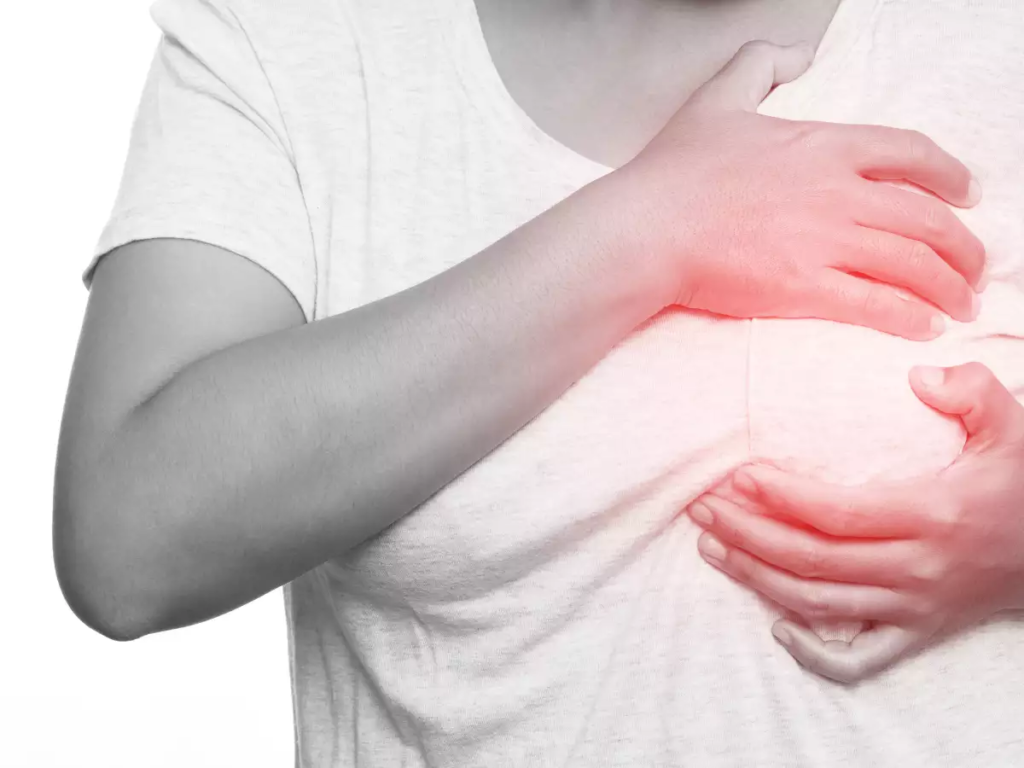Breast cancer is a critical health concern affecting millions of individuals worldwide. Understanding its symptoms and knowing how to detect them early can significantly increase the chances of successful treatment. In this article, we will explore the symptoms of breast cancer, how to recognize them, and provide comprehensive information to raise awareness and promote early detection.
Breast Cancer Symptoms:

Breast cancer can manifest in various ways, and it’s essential to be vigilant about any changes in your breast health. Common symptoms include:
- Lump in the Breast or Underarm: A noticeable lump or thickening in the breast tissue or underarm area.
- Changes in Breast Size or Shape: Sudden changes in breast size, shape, or appearance.
- Nipple Changes: Changes in the nipple, such as discharge (other than breast milk), inversion, or a rash around the nipple.
- Breast Pain: Unexplained pain or tenderness in the breast or nipple area.
- Skin Changes: Skin changes on the breast, like redness, dimpling, or puckering, resembling the texture of an orange peel.
How to Feel for Abnormalities:

Performing regular breast self-exams can aid in early detection. Here’s how to do it effectively:
- In Front of a Mirror: Inspect your breasts visually for any changes in size, shape, or skin texture. Check for nipple discharge or inversion.
- Raise Your Arms: Raise your arms overhead and look for the same changes in the mirror.
- Lying Down: Lie down and use your opposite hand’s fingers to examine your breast in a circular motion, feeling for lumps or thickening. Cover the entire breast and underarm area.
- In the Shower: Some people find it easier to feel for lumps when the skin is wet and slippery. Use the same circular motion while standing in the shower.
Risk Factors and Prevention:
While breast cancer can affect anyone, certain factors increase the risk, including family history, genetic mutations (such as BRCA1 and BRCA2), hormonal factors, and lifestyle choices. While some risk factors cannot be changed, maintaining a healthy lifestyle, regular exercise, a balanced diet, limiting alcohol consumption, and avoiding smoking can help reduce the risk.
Early Detection and Screening:
Regular mammograms are crucial for detecting breast cancer in its early stages, often before symptoms are noticeable. Women are generally recommended to start regular mammograms around the age of 40, or earlier if they have a family history of breast cancer. Additionally, clinical breast exams by healthcare professionals are vital in the early detection process.
Seeking Medical Help:
If you notice any changes in your breasts or experience any of the mentioned symptoms, it is imperative to consult a healthcare professional promptly. Early diagnosis and treatment significantly improve the chances of successful recovery.
Caution, Dos, and Don’ts
Breast cancer is a serious health concern that affects millions of people globally. Being aware of precautions, actions to take, and things to avoid can significantly impact your breast health. In this article, we will provide important information about breast cancer, including cautionary measures, dos, and don’ts to empower you with knowledge and promote proactive health practices.
Cautionary Measures:
- Regular Self-Examinations: Be vigilant about changes in your breast size, shape, lumps, or skin texture. Perform monthly self-exams to detect any abnormalities early.
- Genetic Counseling: If you have a family history of breast cancer, consider genetic counseling to understand your risk and take necessary precautions.
- Healthy Lifestyle: Adopt a balanced diet, exercise regularly, limit alcohol consumption, and avoid smoking. A healthy lifestyle reduces your risk of developing breast cancer.
- Regular Check-ups: Schedule regular clinical breast exams with your healthcare provider. Early detection is key to successful treatment.
- Mammogram Screenings: Follow recommended mammogram guidelines based on your age and risk factors. Mammograms can detect cancerous growths before symptoms appear.
Dos:
- Know Your Family History: Understand your family’s cancer history and discuss it with your healthcare provider. This information can guide your screening schedule.
- Breastfeed, if Possible: If you’re a new mother, consider breastfeeding. It has shown to reduce the risk of breast cancer.
- Stay Informed: Stay updated on the latest research, advancements in treatments, and preventive measures related to breast cancer.
- Supportive Network: Surround yourself with a supportive network of friends and family. Emotional well-being is crucial during any health challenge.
Don’ts:
- Avoid Ignoring Symptoms: If you notice any changes in your breasts, don’t ignore them. Prompt medical attention is crucial.
- Avoid Excessive Alcohol: Limit alcohol consumption, as excessive drinking has been linked to an increased risk of breast cancer.
- Don’t Skip Screenings: Regular mammograms and clinical exams should not be skipped. These screenings can detect cancer in its early stages.
- Avoid Unverified Information: Rely on reputable sources for information about breast cancer. Avoid unverified treatments or remedies.
Caution Regarding Treatment:
- Consultation with Specialists: When diagnosed, consult with oncologists and specialists experienced in breast cancer. Seek a second opinion if needed.
- Consideration of Options: Understand all treatment options, including surgery, chemotherapy, radiation, and immunotherapy. Make informed decisions with your healthcare team.
- Holistic Approach: Consider complementary therapies like counseling, yoga, or support groups to cope with the emotional and mental aspects of cancer treatment.
breast cancer awareness, regular self-examinations, and timely medical screenings are fundamental in the fight against breast cancer. By understanding the symptoms, knowing how to perform self-exams, and being aware of risk factors, individuals can take proactive steps towards early detection and, ultimately, better outcomes. Regular screenings, a healthy lifestyle, and knowledge are powerful tools in the battle against this disease, emphasizing the importance of education and awareness in our communities.

